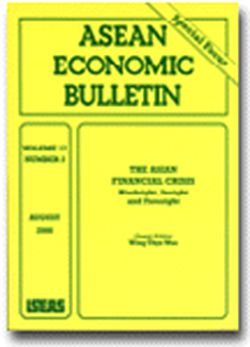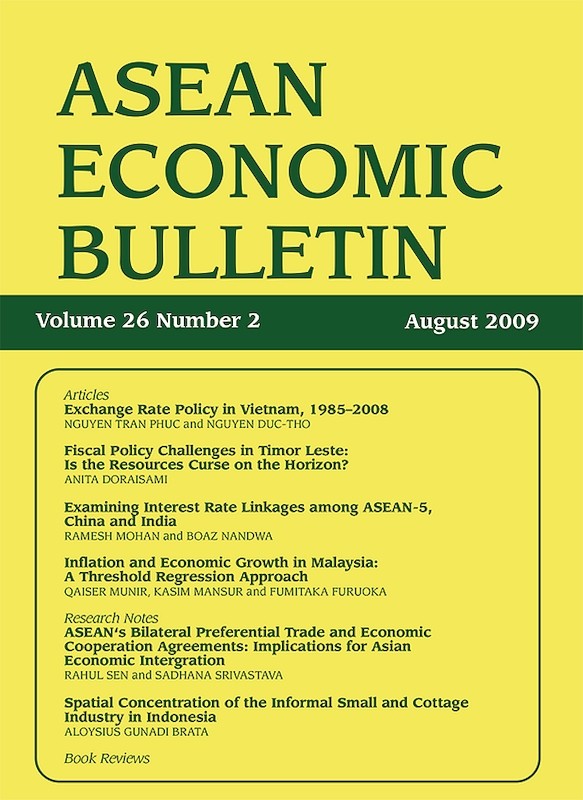-
- ARTICLES
-
Introduction to the Special Focus Issue of ASEAN Economic Bulletin Vol. 18, No. 1 (April 2001)
-
This article examines the extent and causes of globalization and its consequences for the policy strategies of Southeast Asian countries. Added to the digital revolutions contribution to globalization have been substantial policy reforms by national governments in the past two decades. The latter have been partly unilateral and/or regional (as with the ASEAN Free Trade Agreement). But the GATT/WTO has been crucial during the past half century in encouraging economies to open up more and to commit to staying open to international trade and investment. Greater openness of and interdependence between national economies provides bountiful opportunities for ASEAN economies, but it is not without its challenges. Globalization is raising the rewards for economies choosing good economic governance, but is also raising the costs for economies with poor economic governance. Good economic governance requires a permanent commitment to a liberal international trade and payments regime, and to secure property rights.
-
This article discusses an approach to "open regionalism" based on regional production networks and component specialization. Component specialization, or intra-product trade, has been shown to be welfare-enhancing. It creates jobs and raises output by improving competitiveness. It is one of the innovative features of the current phase of globalization. It offers groups of small countries opportunities to make regionalism work in ways which the traditional European model does not. It is less discriminatory and less inward-looking than the European model. It stresses regulatory reform and the creation of a single market early in the process of regional economic integration. The welfare gains flow from elimination of market distortions and minimization of trade diversion.
-
This article analyses the progress of the reintegration of the formerly centrally planned economies into the global trading system, focusing on the relationship between multilateral processes and regional integration schemes. Almost all the countries in transition from central planning have accepted the WTO rule-based system in principle. Although most of the European economies in transition are likely to join the European Union, they will then be in a trading unit which generally respects WTO principles. The regional blocks to which the transition economies of Southeast Asia and the former Soviet Union are attaching themselves do not have a strong record of implementing preferential trade policies. In sum, the potential danger of regionalism proving more attractive than multilateralism has not eventuated. Some implications for ASEAN members are drawn.
-
This article assesses the case for pegging in East Asia by briefly surveying the recent literature on the choice of exchange rate regime. East Asia's experience with pegged exchange rates is examined using a new method for classifying exchange rate regimes based on exchange rate volatility, In contrast to other regions in the world, inflation under pegging is similar to that under floating, as are monetary and fiscal conditions. Growth tends to be higher under pegging, but the channels are unclear since pegging was not associated with greater competitiveness or lower real exchange rate volatility, and openness was not higher under pegging. Before 1997, pegging was associated with higher cumulative inflation, and similar cumulative growth around currency crisis episodes. Thus, differences in economic performance across pegged and floating regimes in East Asia are relatively modest, suggesting that traditional justifications for pegging such as greater inflation credibility may be less important in East Asia than elsewhere. However, the 1997 crises which were preceded by pegged regimes - were followed by unprecedented contractions in output that suggest that the costs of pegging may have risen.
-
This article stresses the role of the central bank when discussing the response of the exchange rate to net capital flows in selected East Asian countries. We argue that the priority of central banks is the inflation rate but this priority sometimes becomes obscured by other factors. This article considers the sources of inflation and economic competitiveness as the two other factors. We argue that low inflation may result from strong productivity in a boom or from weak demand in a recession. Similarly, high inflation may result from strong demand or from a fiscally irresponsible government. Capital inflows would be expected in the former case and outflows would be anticipated in the latter case. The extent of the intervention of central banks and the resulting responses of the exchange rate will therefore vary based on the circumstances. The empirical details conducted in this article for selected Asian economies broadly confirm these hypotheses.
-
In this article we undertake an empirical investigation of the impact of interest rates and real exchange rates on financial deepening in four Asian countries, South Korea, Malaysia, Thailand, and Indonesia. We find that the financial deepening ratio (proxied by the ratio of broad money to GDP) generally increases with higher real interest rates and with real currency depreciation. Foreign assets seem to have become important in the East Asian countries (except Malaysia), suggesting that at least some of the assets coming to the banking system in response to higher interest rates could be at the expense of foreign assets held by domestic residents. This implies that higher real interest rates are likely to increase investment ratios in these economies. These results support a policy of interest rate liberalization, although this ought to be done in a controlled and gradual fashion to minimize the potential for financial distress.
-
One of the earliest collective responses of the regional economies to the financial crisis was to call for the establishment of a regional surveillance and monitoring mechanism. This article examines the role and limitations of the ASEAN surveillance process in the context of crisis-prevention. A review of the gaps in existing global and national surveillance systems in Asia highlights some of the challenges for the successful development of the ASEAN surveillance process.
-
This article discusses the political economy context surrounding the Japanese proposal for an Asian Monetary Fund as well as highlights other recent initiatives towards enhanced monetary regionalism. The discussion reveals the keenness that the region has shown towards intensified cooperation in these areas. Nevertheless, the economic/political economy rationale for such cooperation does not appear to have been fully articulated, a void that this paper attempts to fill. Insofar as "regional contagion" is seen as providing the analytical basis for monetary regionalism, a large part of the discussion is devoted to defining and highlighting the various transmission channels through which currency and financial crises may spread contagiously and drawing out policy implications thereof.
-
The unfolding globalization process, centring on production and distribution network and on financial institutions, products, and transactions, is having a profound impact on a wide range of policies and practices in both the private and the public sectors. This article analyses the implications of globalization and the resulting greater integration of the world economy on tax systems in developing countries in general, and Southeast Asian countries in particular. Issues discussed include international factor mobility and the resulting consequences for efficiency and burden of taxation; tax competition among various jurisdictions to attract foreign direct investment (FDI) and professional and technical manpower; the impact of globalization on indirect taxation, including international trade taxation; tax implications of the Internet and E-commerce; taxation of global portfolio flows (i.e. non-FDI flows); and the impact of globalization on fiscal sustainability in Southeast Asia.







